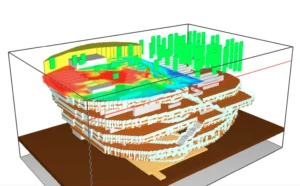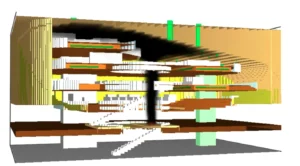CONTAM involves modeling the conditions within a space during a fire to determine if the conditions are survivable for occupants.
 What is CONTAM?
What is CONTAM?
CONTAM is a computer software program developed by the National Institute of Standards and Technology (NIST) that can provide valuable information about the behavior of smoke and combustion products during a fire. “CONTAM is widely used for tenability analysis by fire protection professionals at TERPconsulting to assess the safety of occupants by evaluating whether the environment inside a building during a fire is safe for occupants to breathe and move through, based on the levels of smoke and toxic gases present,” explains fire protection consultant Lana Benny, EIT, AIFireE of TERPconsulting.
How have fire protection engineers most effectively used CONTAM?
One of the most well-known tenability studies using CONTAM focused on the World Trade Center towers in New York City after the terrorist attacks on September 11, 2001. In the aftermath of the attacks, there were concerns about the safety of high-rise buildings in general and the ability of occupants to safely evacuate in the event of a fire or other emergency. To address these concerns, researchers used CONTAM to model the conditions within the World Trade Center towers during the attacks.
The CONTAM analysis of the Twin Towers allowed researchers to evaluate the tenability of the conditions within the towers during the attacks and to identify areas where improvements could be made to enhance occupant safety in the future. The study’s findings contributed to developing new building codes and fire safety standards, including requirements for more robust fire suppression and evacuation systems, improved communication systems, and enhanced training for building occupants and emergency responders.
How does CONTAM assist in designing effective smoke control systems?
Performing a tenability analysis using CONTAM involves modeling the conditions within a space during a fire or other hazardous event to determine if the conditions are tenable or survivable for occupants. By simulating the movement of smoke and combustion products, CONTAM helps the engineers and designers at TERPconsulting understand how a fire might spread through a building and how smoke might move within the building. This information can be used to design more effective smoke control systems, which can help prevent the spread of fire and smoke and provide occupants with a safe means of egress.



 What is CONTAM?
What is CONTAM? “The output of a tenability analysis includes predictions of temperature, gas concentrations, and visibility levels within the space over time. These predictions can be used to assess whether the conditions within the space are safe for occupants and to help the fire protection engineers at
“The output of a tenability analysis includes predictions of temperature, gas concentrations, and visibility levels within the space over time. These predictions can be used to assess whether the conditions within the space are safe for occupants and to help the fire protection engineers at